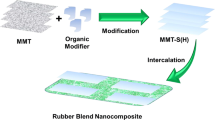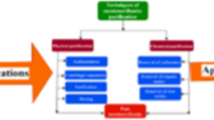Abstract
Most natural and synthetic rubbers have inherently high flammability, a property which limits their uses. The aim of the present work was to study the effect of organo-montmorillonite (OMMT) and modified OMMT on the flame-retardance and mechanical properties of natural rubber (NR) composites. The OMMT was modified with hyper-branched polymer via condensation polymerization between the intercalation agent, N,N-di(2-hydroxyethyl)-N-dodecyl-N-methylammonium chloride, and the monomer, N,N-dihydroxyl-3-aminomethyl propionate. This modified OMMT was then reacted with phosphate, and a novel flame-retardant hyper-branched organic montmorillonite (FR-HOMMT) was thus obtained. The surface morphology, interlayer space, interlamellar structure, and thermal properties of these modified clays were investigated by Fourier-transform infrared spectroscopy, scanning electron microscopy, X-ray diffraction, and thermogravimetric analysis. The FR-HOMMT showed increased basal spacing and better thermal stabilities due to the different arrangement and thermal stability of the novel organic macromolecular surfactant. Natural rubber NR/OMMT and NR/FR-HOMMT composites were prepared by conventional compounding with OMMT and the phosphorus-based organo-montmorillonite. The cure characteristics, tensile strength, wear resistance, thermal stabilities, and flame-retardant properties were researched and compared. The best dispersion of this modified clay was observed for 20 phr (parts per hundred of rubber) of FR-HOMMT-filled composite, which resulted in the best mechanical performance with an increase of 47% in tensile strength, of 40% in elongation at break, and decrease of 140% in abrasion loss compared with 20 phr of the OMMT-filled matrix. A mechanism for reinforcing and flame retardance is proposed here. The 'anchor' effect caused by the hyper-branched polymer may decrease the number and size of the voids in the NR matrix, and thus increase the crack path during tensile drawing. Meanwhile, the flame retardance of the OMMT and the phosphate may increase the number of carbonaceous layers, thus inhibiting the degree of pyrolysis of the NR matrix during burning.
Similar content being viewed by others
References
Aouad, A., Anastácio, A.S., Bergaya, F., and Stucki, J.W. (2010) A Mössbauer spectroscopic study ofal uminum- and iron-pillared clay minerals. Clays and Clay Minerals, 58, 164–173.
ASTM D2084-81 (2011) Standard test method for rubber property-vulcanization using oscillating disk cure meter. American Society for Testing and Materials.
ASTM D2863-10 (2011) Standard test method for measuring the minimum oxygen concentration to support candle-like combustion ofplastics (oxygen index). American Society for Testing and Materials.
Boo, W.J., Liu, J., and Sue, H.J. (2006) Fracture behavior of nanoplatelet reinforced polymer nanocomposites. Material Science and Technology, 22, 829–834.
Burwell, J.T. (1957) Survey ofpossible wear mechanism. Wear, 1, 119–123.
Calderon, J.U., Lennox, B., and Kamal, M.R. (2008) Thermally stable phosphonium-montmorillonite organo-clays. Applied Clay Science, 40, 90–98.
Churchman, G.J., Gates, W.P., Theng, B.K.G., and Yuan, G. (2006) Clays and clay minerals for pollution control. Pp. 625–675 in: Handbook of Clay Science (F. Bergaya, B.K.G. Theng, and G. Lagaly, editors). Elsevier, Amsterdam.
Dai, C.F., Li, P.R., and Yeh, J.M. (2008) Comparative studies for the effect of intercalating agent on the physical properties ofep oxy resin-clay based nanocomposite materials. European Polymer Journal, 44, 2439–2447.
Dong, Y.M. (2004) Polymer Analysis Handbook. China Petrochemical Press, Beijing, pp. 521–522.
Fang, S.L., Hu, Y., Song, L., and Wu, J. (2009) Preparation and investigation ofethylene-vinyl acetate copolymer/silicone rubber/clay nanocomposites. Journal of Applied Polymer Science, 113, 1664–1670.
Gatos, K.G., Sawanis, N., Apostolov, A.A., Thomann, R., and Karger-Kocsis, J. (2004) Nanocomposite formation in hydrogenated nitrile rubber (HNBR)/organo-montmorillonite as a function of intercalant type. Macromolecular Materials and Engineering, 289, 1079–1086.
Gu, Z., Song, G.J., Liu, W.S., Yang, S.J., and Gao, J.M. (2010) Structure and properties ofhyd rogenated nitrile rubber/organo-montmorillonite nanocomposites. Clays and Clay Minerals, 58, 72–78.
Hassan, M.A., Kozlowski, R., Obidzinski, B., Shehata, A.B., and Aziz, F.A. (2007) The effect of new flame retardant systems containing montmorillonite-butyl acrylate nanoclay on the flammability properties of polyuerethane polymer. Polymer-Plastics Technology and Engineering, 46, 521–527.
He, H., Ding, Z., Zhu, J., Yuan, P., Xi, Y., Yang, D., and Frost, R.L. (2005) Thermal characterization of surfactant-modified montmorillonite. Clay and Clay Minerals, 53, 287–293.
Hedley, C.B., Yuan, G., and Theng, B.K.G. (2007) Thermal analysis ofmo ntmorillonites modified with quaternary phosphonium and ammonium surfactants. Applied Clay Science, 35, 180–188.
Hu, Y., Tang, Y., and Song, L. (2006) Poly(propylene)/clay nanocomposites and their application in flame retardancy. Polymers for Advanced Technologies, 17, 235–245.
Ismail, H., Munusamy, Y., Mariatti, M., and Ratnam, C.T. (2008) Preparation and characterization ofEVA/S MRL/organo-clay nanocomposites: effect of blending sequences and organo-clay loading. Polymer-Plastics Technology and Engineering, 47, 752–761.
Labruyèrè, C., Monteverde, F., Alexandre, M., and Dubois, P. (2009) Exfoliation of clays in poly(dimethylsiloxane) rubber using an unexpected couple: a silicone surfactant and water. Journal of Nanoscience and Nanotechnology, 9, 2731–2738.
Lagaly, G., Ogawa, M., and Dekany, I. (2006) Clay mineralorganic interactions. Pp. 309–377 in: Handbook of Clay Science (F. Bergaya, B.K.G. Theng, and G. Lagaly, editors). Elsevier, Amsterdam.
Lee, S.Y., Cho, W.J., Kim, K.J., Ahn, J.H., and Lee, M. (2005) Interaction between cationic surfactants and montmorillonite under non-equilibrium conditions. Journal of Colloid and Interface Science, 284, 667–673.
Li, B., Jia, H., Guan, L.M., Bing, B.C., and Dai, J.F. (2009) A novel intumescent flame-retardant system for flame-retarded LLDPE/EVA composites. Journal of Applied Polymer Science, 114, 3626–3635.
Liu, T.X., Lim, K.P., Tjiu, W.C., Pramoda, K.P., and Chen, Z.K. (2003) Preparation and characterization ofnyl on 11/organo-clay nanocomposites. Polymer, 44, 3529–3535.
Ma, J., Xu, J., Ren, J.H., Yu, Z.Z., and Mai, Y.W. (2003) A new approach to polymer/montmorillonite nanocomposites. Polymer, 44, 4619–4624.
Marlene, R., Christopher, J.G.P., Laszlo, G., Yves, L., Henri, J.M.G., and Jan-Anders, E.M. (2004) Hyperbranched polymer/montmorillonite clay nanocomposites. Polymer, 45, 949–960.
Menon, A.R.R. (1997) Flame-retardant characteristics of natural rubber modified with a bromo derivative of phosphorylated cashew nut shell liquid. Journal of Fire Sciences, 15, 3–13.
Monasterio, F.E., Dias, M.L., Pita, V.J.R.R., Erdmann, E., and Destéfanis, H.A. (2010) Effect of the organic groups of difunctional silanes on the preparation of coated clays for olefin polymer modification. Clay Minerals, 45, 489–502.
Powell, C.E. and Beall, G.W. (2007) Physical properties of polymer/clay nanocomposites. Pp. pp 561–575 in: Physical Properties of Polymers Handbook. Springer, Berlin.
Ramesan, M.T. (2005) The effects of filler content on cure and mechanical properties ofdichlorocar bene modified styrene butadiene rubber/carbon black composites. Journal of Polymer Research, 11, 333–340.
Ruiz-Hitzky, E. and Van Meerbeek, A. (2006) Clay minerals and organoclay-polymer nanocomposites. Pp. 583–621 in: Handbook of Clay Science (F. Bergaya, B.K.G. Theng, and G. Lagaly, editors). Elsevier, Amsterdam.
Shen, W., He, H.P., Zhu, J.X., Yuan, P., Ma, Y.H., and Liang, X.L. (2009) Preparation and characterization of3-aminopropyltriethoxysilane grafted montmorillonite and acidactivated montmorillonite. Chinese Science Bulletin, 54, 265–271.
Tan, H.M. and Luo, Y.J. (2005) Hyper-branched Polymers, Chemical Industry Press, Beijing.
Wang, J.C. and Chen, Y.H. (2007) Synthesis ofan intumescent flame retardant (IFR) agent and application in a natural rubber (NR) system. Journal of Elastomers and Plastics, 39, 33–51.
Wang, J.C., Chen, Y.H., and Jin, Q.Q. (2006) Preparation and characteristics ofa novel silicone rubber nanocomposite based on organophilic montmorillonite. High Performance Polymers, 18, 325–340.
Wang, J.C., Chen, Y.H., Jin, Q.Q., Tang, Y., and Xu, M.M. (2009a) Preparation, properties, and mechanism ofnov el polyurethane adhesive/organic montmorillonite nanocomposites. High Performance Polymers, 21, 155–171.
Wang, J.C., Chen, Y.H., and Wang, J.H. (2009b) Synthesis of hyperbranched organo-montmorillonite and its application into high-temperature vulcanizated silicone rubber systems. Journal of Applied Polymer Science, 111, 658–667.
Wang, J.C., Yang, K., and Zheng, X.Y. (2009c) Preparation and characterization ofh yper-branched and nano-typeorgano-montmorillonite silicate layers. Proceedings of 2009 International Conference on Advanced Fibers and Polymer Materials, Volume II, 1019–1022.
Xi, Y., Martens, W., He, H., and Frost, R.L. (2005) Thermogravimetric analysis ofor gano-clays intercalated with the surfactant octadecyltrimethylammonium bromide. Journal of Thermal Analysis and Calorimetry, 81, 91–97.
Xia, Y., Jian, X.G., Li, J.F., Wang, X.H., and Xu, Y.Y. (2007) Synergistic effect of montmorillonite and intumescent flame retardant on flame retardance enhancement of ABS. Polymer-Plastics Technology and Engineering, 46, 227–232.
Xie, W., Gao, Z., Pan, W.P., Hunter, D., Singh, A., and Vaia, R. (2001) Thermal degradation chemistry ofal kyl quaternary ammonium montmorillonite. Chemistry of Materials, 13, 2979–2990.
Xie, W., Xie, R., Pan, W.P., Hunter, D., Koene, B., Tan, L.S., and Vaia, R. (2002) Thermal stability ofqu aternary phosphonium modified montmorillonite. Chemistry of Materials, 14, 4837–4845.
Xu, B., Zheng, Q., Song, Y.H., and Shangguan, Y. (2006) Calculating barrier properties ofpolymer/clay nanocomposites: effect of clay layers. Polymer, 47, 2904–2910.
Yoon, K.B., Sung, H.D., Hwang, Y.Y., Noh, S.K., and Lee, D.H. (2007) Modification of montmorillonite with oligomeric amine derivatives for polymer nanocomposite preparation. Applied Clay Science, 38, 1–8.
Zhao, F., Bao, X.J., Andrew, R.M., Gu, J.J., Wan, C.Y., and Bala, K. (2010) Effect of POSS on morphology and mechanical properties ofpol yamide 12/montmorillonite nanocomposites. Applied Clay Science, 47, 249–256.
Zhou, N.L., Xia, X.X., and Wang, Y.R. (2002) Study on mechanical property ofexf oliated silicone rubber/clay nanocomposites. Acta Polymerica Sinica, 2, 253–256.
Zhu, J.X., Zhu, L.Z., Zhu, R.L., Tian, S.L., and Li, J.W. (2009) Surface microtopography of surfactant modified montmorillonite. Applied Clay Science, 45, 70–75.
Author information
Authors and Affiliations
Corresponding author
Rights and permissions
About this article
Cite this article
Wang, J., Guo, X., Zheng, X. et al. Enhanced Flame-Retardant Capacity of Natural Rubber/Organo-Montmorillonite and Hyper-Branched Organo-Montmorillonite Composites. Clays Clay Miner. 59, 446–458 (2011). https://doi.org/10.1346/CCMN.2011.0590502
Received:
Revised:
Published:
Issue Date:
DOI: https://doi.org/10.1346/CCMN.2011.0590502




